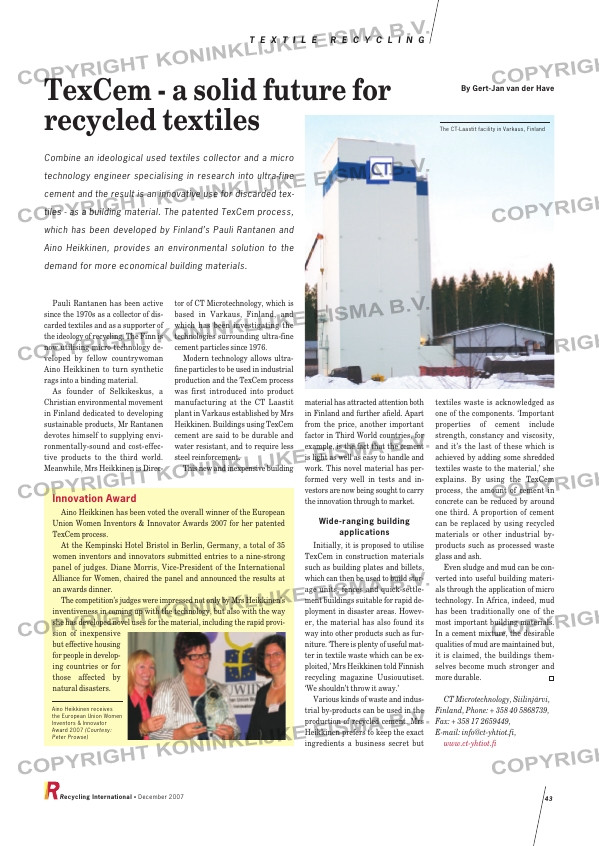Page 43 from: December 2007

Pauli Rantanen has been active
since the 1970s as a collector of dis-
carded textiles and as a supporter of
the ideology of recycling. The Finn is
now utilising micro technology de-
veloped by fellow countrywoman
Aino Heikkinen to turn synthetic
rags into a binding material.
As founder of Selkikeskus, a
Christian environmental movement
in Finland dedicated to developing
sustainable products, Mr Rantanen
devotes himself to supplying envi-
ronmentally-sound and cost-effec-
tive products to the third world.
Meanwhile, Mrs Heikkinen is Direc-
tor of CT Microtechnology, which is
based in Varkaus, Finland, and
which has been investigating the
technologies surrounding ultra-fine
cement particles since 1976.
Modern technology allows ultra-
fine particles to be used in industrial
production and the TexCem process
was first introduced into product
manufacturing at the CT Laastit
plant in Varkaus established by Mrs
Heikkinen. Buildings using TexCem
cement are said to be durable and
water resistant, and to require less
steel reinforcement.
This new and inexpensive building
material has attracted attention both
in Finland and further afield. Apart
from the price, another important
factor in Third World countries, for
example, is the fact that the cement
is light as well as easy to handle and
work. This novel material has per-
formed very well in tests and in-
vestors are now being sought to carry
the innovation through to market.
Wide-ranging building
applications
Initially, it is proposed to utilise
TexCem in construction materials
such as building plates and billets,
which can then be used to build stor-
age units, fences and quick-settle-
ment buildings suitable for rapid de-
ployment in disaster areas. Howev-
er, the material has also found its
way into other products such as fur-
niture. ‘There is plenty of useful mat-
ter in textile waste which can be ex-
ploited,’ Mrs Heikkinen told Finnish
recycling magazine Uusiouutiset.
‘We shouldn’t throw it away.’
Various kinds of waste and indus-
trial by-products can be used in the
production of recycled cement. Mrs
Heikkinen prefers to keep the exact
ingredients a business secret but
textiles waste is acknowledged as
one of the components. ‘Important
properties of cement include
strength, constancy and viscosity,
and it’s the last of these which is
achieved by adding some shredded
textiles waste to the material,’ she
explains. By using the TexCem
process, the amount of cement in
concrete can be reduced by around
one third. A proportion of cement
can be replaced by using recycled
materials or other industrial by-
products such as processed waste
glass and ash.
Even sludge and mud can be con-
verted into useful building materi-
als through the application of micro
technology. In Africa, indeed, mud
has been traditionally one of the
most important building materials.
In a cement mixture, the desirable
qualities of mud are maintained but,
it is claimed, the buildings them-
selves become much stronger and
more durable.
CT Microtechnology, Siilinjärvi,
Finland, Phone: + 358 40 5868739,
Fax: + 358 17 2659449,
E-mail: [email protected],
www.ct-yhtiot.fi
T E X T I L E R E C Y C L I N G
Recycling International • December 2007 43
TexCem – a solid future for
recycled textiles
Combine an ideological used textiles collector and a micro
technology engineer specialising in research into ultra-fine
cement and the result is an innovative use for discarded tex-
tiles – as a building material. The patented TexCem process,
which has been developed by Finland’s Pauli Rantanen and
Aino Heikkinen, provides an environmental solution to the
demand for more economical building materials.
By Gert-Jan van der Have
The CT-Laastit facility in Varkaus, Finland
Innovation Award
Aino Heikkinen has been voted the overall winner of the European
Union Women Inventors & Innovator Awards 2007 for her patented
TexCem process.
At the Kempinski Hotel Bristol in Berlin, Germany, a total of 35
women inventors and innovators submitted entries to a nine-strong
panel of judges. Diane Morris, Vice-President of the International
Alliance for Women, chaired the panel and announced the results at
an awards dinner.
The competition’s judges were impressed not only by Mrs Heikkinen’s
inventiveness in coming up with the technology, but also with the way
she has developed novel uses for the material, including the rapid provi-
sion of inexpensive
but effective housing
for people in develop-
ing countries or for
those affected by
natural disasters.
Aino Heikkinen receives
the European Union Women
Inventors & Innovator
Award 2007 (Courtesy:
Peter Prowse)
RI_034 TexCem:Opmaak 1 06-12-2007 14:58 Pagina 43



